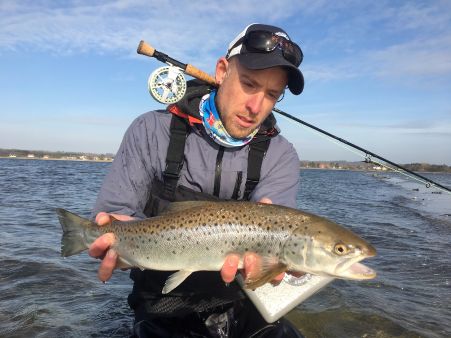There is only a few species of fish that can have so many different sizes, colours or just behaviour then trout (brown trout, sea, ...). This fish of our dreams will remain a myth for its polymorphism and ability to adapt to diametrically aquatic opposed environments from various freshwater to more or less salty waters of seas and oceans.
Despite the different ecological forms of the brown trout, the sea trout has only a little in common with the brown trout. It should be noted that their DNA is identical and the first period of their life cycle both the sea- and brown trout will spend about one and half year in the river. Undeniably, I see that the behaviour of sea trout is much closer to the salmon, both are migratory anadromous but the sea trout does not travel thousands of kilometres. Sea trouts are migratory "coastal" without remaining restricted to the estuaries of their origin rivers. Sea trout will not hesitate to travel up to a couple hundreds of kilometers.
It’s well known that the sea trout lives in shoal that can be represented by a few individuals up to hundreds. When going to sea, Sea-Trout congregate in shoal, which is also is one of the best protection against predators such as groups of porpoises, seals, cormorants.
In order to adapt easily to different habitat, the sea-trout has to be more efficient and opportunistic during hunting different prey. Keeping in mind that the periods of non-dieting are characterized by a rejection of all foods. Feeding behaviour is adapted to the marine environment and in optimal conditions they literally can increase their size several times, from approximately 15 cm after the downstream migration to measure between 45 and 55 cm in late autumn, before to spending the first winter at sea. The influences of climate and the richness or lack of it in the environment can disrupt or enhance from one year to another.
During this migration in the sea trout gains kilograms, which could not be obtained in such a short time in fresh water and significantly improves the survival of the species (brown trout). A female can easily weigh 2 kg before the first winter and therefore the ratio of the eggs/weigh are improved significantly by the increase of the total weigh. The phenomenon is obvious in Denmark where the sea trout spend an average of 2 to 3 winters and in exceptionally chases up to 4-5 winters at sea before making the run for the first breeding.
Unlike salmon, sea trout has the ability to have several breeding periods despite a survival rate after reproduction between 30 and 50% as a maximum. The survivors re-conduct a new downstream migration to grow a few cm more but above all to gain weigh. From that moment, they will have a record size of about 60 cm and the weigh can be from 6 to 12 Kg. Danish historical record from 1991, the sea-trout measured 1.08 to 16.3 kg and 9 years old.





